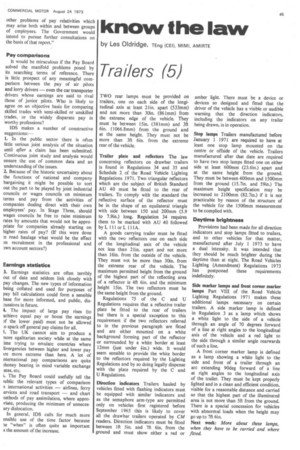know the law
Page 47

If you've noticed an error in this article please click here to report it so we can fix it.
by Les Oldridge, TEng (CEO, MIMI, AMIRTE
Trailers (5)
TWO rear lamps must be provided on trailers, one on each side of the longitudinal axis at least 21in. apart (533mm) and not more than 30in. (861mm) from the extreme edge of the vehicle. They must be between 15in. (381mm) and 3ft 6in. (1066.8mm) from the ground and at the same height. They must not be more than 3ft 6in. from the extreme rear of the vehicle.
Trailer plate and reflectors The law concerning reflectors on drawbar trailers is found in Regulations 34 and 35 and Schedule 2 of the Road Vehicle Lighting Regulations 1971. Two triangular reflectors which are the subject of British Standard AU 40 must be fitted to the rear of trailers. To comply with the standard the reflective surface of the reflector must be in the shape of an equilateral triangle with side between 150 and 200mm (5.9 to 7.9in.) long. Regulation 34 requires them to be marked with AU 40 followed by L III or L 111A.
A goods carrying trailer must be fitted with the two reflectors one on each side of the longitudinal axis of the vehicle not less than 21in. apart and not more than 16in. from the outside of the vehicle. They must not be more than 30in. from the extreme rear of the vehicle. The maximum permitted height from the ground of the highest part of the reflecting area of a reflector is 4ft 6in. and the minimum height 15in. The two reflectors must be the same height from the ground.
Regulations 75 of the C and U Regulations requires that a reflective trailer plate be fated to the rear of trailers but there is a special exception to this requirement if the two reflectors referred to in the previous paragraph are fitted and are either mounted on a white background forming part of the reflector or surrounded by a white border at least 12mm (just under +in.) wide. It would seem sensible to provide the white border to the reflectors required by the Lighting Regulations and by so doing legally dispense with the plate required by the C and U Regulations.
Direction indicators Trailers hauled by vehicles fitted with flashing indicators must be equipped with similar indicators and as the semaphore arm-type are permitted only on vehicles first registered before September 1965 this is likely to cover all the drawbar trailers operated by CM readers. Direction indicators must be fitted between lft 5in. and 7ft 6in. from the ground and must show either a red or
amber light. There must be a device or devices so designed and fitted that the driver of the vehicle has a visible or audible warning that the direction indicators, including the indicators on any trailer being drawn, is in operation.
Stop lamps Trailers manufactured before January 1 1971 are required to have at least one stop lamp mounted on the centre or offside of the vehicle. Trailers manufactured after that date are required to have two stop lamps fitted one on either side at least 600mm (23.6in.) apart and at the same height from the ground. They must be between 400mm and 1500mm from the ground (15.7in. and 59in.) The maximum height specification may be increased to 2100mm (82.7in.) if it is not practicable by reason of the structure of the vehicle for the 1500mm measurement to be complied with.
Daytime brightness Provisions had been made for all direction indicators and stop lamps fitted to trailers, and to other vehicles for that matter, manufactured after July 1 1973 to have a dual intensity. It was intended that they should be much brighter during the daytime than at night. The Road Vehicles Lighting (Amendment) Regulations 1973 has postponed these requirements indefinitely.
Side marker lamps and front corner marker lamps Part VIII of the Road Vehicle Lighting Regulations 1971 makes these additional lamps necessary on certain trailers. A side marker lamp is defined in Regulation 3 as a lamp which shows a white light to the side of a vehicle through an angle of 70 degrees forward of a line at right angles to the longitudinal axis of the vehicle and a red light to the side through a similar angle rearwards of such a line.
A front corner marker lamp is defined as a lamp showing a white light to the side and front of a trailer through an arc extending 90deg forward of a line at right angles to the longitudinal axis of the trailer. They must be kept properly lighted and in a clean and efficient condition, visible for a reasonable distance and carried so that the highest part of the illuminated area is not more than 5ft from the ground. There is a special concession for vehicles with abnormal loads when the height may go up to 7ft 6in.
Next week: More about these lamps, when they have to be carried and where fitted




















































































